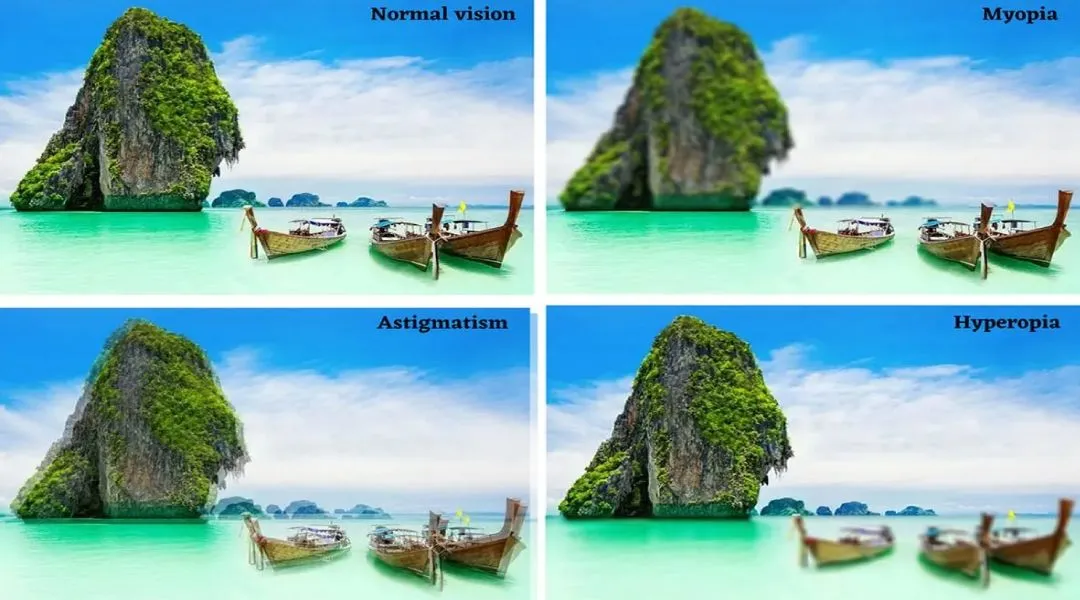
Eye strain and glare in the evening: A sign of visual overload
1/ Eye strain and glare in the evening: A sign of visual overload In today’s digital lifestyle, our eyes are constantly exposed to electronic screens, artificial light, and intense focusing demands. Feeling tired eyes, forehead tension, or glare at the end of the day is becoming increasingly common. However, many people ignore these signs, unaware […]

Do myopia control glasses for children really work?
Do myopia control glasses for children really work? School myopia – especially progressive myopia – is no longer a rare condition. WHO predicts that by 2050, about 50% of the global population will be myopic, with 10% developing high myopia (≥ -6.00D), leading to a higher risk of blindness due to retinal disease, macular degeneration, […]

Progressive Myopia: Rapid Worsening and Hard to Control
1/ Progressive Myopia: Rapid Increase and Difficult to Control Progressive myopia is not just about a prescription that increases over time. It’s a long-term, silent, and potentially dangerous process where nearsightedness continues to worsen and becomes difficult to manage using conventional methods. In children, this condition may affect visual development, academic performance, and future quality […]

Clear Signs Your Child Needs an Eye Exam
Clear Signs Your Child Needs an Eye Exam Vision is a vital component in a child’s physical development, cognition, and learning. According to the U.S. National Eye Institute (NEI), up to 80% of the information children acquire from their surroundings is processed through vision. Early detection of vision issues not only impacts clarity but also […]

A Nutritious Diet to Keep Your Eyes Bright Every Day
A Nutritious Diet to Keep Your Eyes Bright Every Day You may work out to stay fit or use skincare to stay youthful — but what about your eyes? When vision fades, no cream can save it. The good news is: a well-balanced, nutrient-rich diet can keep your eyes sharp every day, even as you […]

Everyday Habits That Quietly Damage Your Vision
Vision Decline from Daily Habits: Hidden Risks from the Most Ordinary Actions Blue light from screens causes eye fatigue and accommodative dysfunction Vision doesn’t only deteriorate with age — it can worsen due to repeated, seemingly harmless daily behaviors. Scrolling on your phone in the dark, staring at screens for too long, or forgetting to […]

How Phakic ICL Enhances Your Night Vision
Phakic ICL significantly improves night vision Many people notice something strange: their vision is clear during the day but becomes blurry, glaring, or surrounded by halos at night. Even if daytime vision is sharp, night vision problems can affect driving, working, or navigating in low-light conditions. This issue is especially common in people with high […]

Eye Strain After Prolonged Screen Use May Be Caused By Ciliary Muscle Spasm.
Many people experience eye pain, dryness, or blurred vision after extended periods of using digital devices. The cause is not always dry eyes or nearsightedness—it may also involve a condition known as ciliary muscle spasm. This article will help you understand the underlying mechanism, recognize the symptoms, and learn simple ways to manage the condition at home or with guidance from an eye care professional.

Refractive Errors: Classification and Optical Characteristics
What Are Refractive Errors? Refractive errors occur when the eye cannot properly focus light onto the macula — the central region of the retina responsible for sharp vision. When light is not focused precisely, images appear blurry, distorted, or lack detail. Refractive errors are not diseases but common optical disorders. According to the World Health […]

Abnormal Pupil Dilation and Constriction Can Affect Night Vision
Role of Pupil in Night Vision Dilated pupils or abnormal constriction is one of the overlooked causes of impaired night vision. When pupils fail to respond properly to light, it can prevent light from focusing accurately on the macula — the center of sharp vision — resulting in blur, glare, or disorientation in low-light environments. […]

 vi
vi